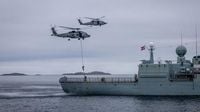In the icy fjords and rugged mountains of Greenland, the world’s largest island has become the unlikely stage for one of Europe’s largest military exercises in recent memory. Denmark, together with hundreds of troops from NATO allies France, Germany, Sweden, and Norway, is leading the Arctic Light 2025 drills—a show of strength and unity that’s as much about deterring potential threats as it is about sending a message to friends and rivals alike.
On September 15, 2025, Danish forces, supported by special units and observed by military personnel from the United States, United Kingdom, Canada, Sweden, and Germany, conducted a dramatic shipboard landing on the frigate Niels Juel. Helicopters buzzed overhead, fast boats sliced through freezing waters, and F-16 fighter jets screamed by in a demonstration of joint operational readiness. The temperature hovered around freezing, but the political atmosphere felt even chillier, with tensions over the future of Greenland never far from anyone’s mind.
According to Reuters and the Associated Press, more than 550 service members are participating in the exercises, which are designed to strengthen the operational readiness of both Denmark and Greenland’s armed forces. The goal? To reinforce their joint response capabilities against destabilizing threats in the North Atlantic and the Arctic—a region that’s become increasingly important as global powers jockey for influence.
This year’s Arctic Light maneuvers are part of Denmark’s intensified military presence in the region, a campaign that began in earnest in June. It’s no coincidence that the drills come on the heels of controversial statements by former U.S. President Donald Trump. In late 2024, Trump declared that “the United States of America feels that the ownership and control of Greenland is an absolute necessity,” and did not rule out taking the island by force. These remarks, widely reported by CNN and AP, sent shockwaves through European capitals and prompted Denmark to take a hard look at its own Arctic defenses.
Greenland, an autonomous territory of Denmark with just 57,000 residents, sits atop vast reserves of minerals and boasts strategic facilities that make it a geopolitical prize. The island’s position along the so-called GIUK gap—an acronym for Greenland, Iceland, and the United Kingdom—controls maritime access to the North Atlantic, a fact that’s not lost on military planners from Washington to Moscow.
“The message to all our allies is that we are protecting the Kingdom of Denmark,” Major General Søren Andersen, chief of Denmark’s Joint Arctic Command, told CNN during a tour of the HDMS Niels Juel. “I don’t think we have a threat to Greenland right now,” he explained, adding, “We see Russia is active in the Arctic Ocean, in the Bering Strait between Alaska and Russia, but not here.”
Still, Danish officials remain wary. Russia, they note, has been steadily increasing its offensive capabilities in the Arctic for more than two decades. China, too, has declared itself a “near-Arctic state” and has invested heavily in infrastructure projects and joint exercises with Russian vessels. Yet, for now, the main concern in Copenhagen isn’t Moscow or Beijing—it’s the shifting winds in Washington.
Denmark’s response has been swift and substantial. In January 2025, the government announced an agreement worth roughly 14.6 billion kroner (about €1.95 billion) to improve surveillance and sovereignty capabilities in Greenland and the North Atlantic. More than $2 billion has been added to Arctic defense spending, and Denmark has established a special forces group dedicated to Arctic operations. The country is also investing in new naval vessels and long-range drones, all aimed at reinforcing its control over its Arctic holdings.
Perhaps the most telling move, as reported by CNN, was Denmark’s recent decision to spend more than $9 billion on air defense systems from European manufacturers, bypassing American Patriot missile batteries. A Western diplomat described this as a “potent reminder that high-value arms procurement often carries a political message.” While Danish officials insist they will continue to buy American military hardware—including the possibility of more F-35 warplanes—the air defense deal is widely seen as a rebuke to Trump’s aggressive rhetoric.
The exercises themselves are a blend of high drama and everyday military professionalism. On the deck of the Niels Juel, guests and allied observers watched live-fire naval artillery drills echo across the stark landscape, while fighter jets performed flybys overhead. According to AP, the drills also included boarding exercises with special forces and joint operations designed to simulate responses to potential threats in the region.
Despite the saber-rattling, the relationship between Denmark and the United States military remains strong—at least on the ground. “We have worked together with the US for decades, both in exercises and also operations in Afghanistan, Iraq and so on,” Maj. Gen. Andersen told Reuters. Denmark even plans to deploy its fighter jets to the US Pituffik Space Base in northwestern Greenland, with Andersen joking, “We will land up there, and I think the pilots will have a cup of coffee with the base commander there.”
Yet, beneath the camaraderie, there’s a clear sense of unease. Both Denmark and Greenland have categorically rejected any notion of selling the island or ceding control, and they have condemned reports of covert US intelligence operations and influence campaigns on Greenlandic soil. Last month, Denmark’s foreign minister summoned the top US diplomat in Copenhagen after a national broadcaster reported that individuals with connections to Trump had been conducting covert influence operations in Greenland—a move that only heightened suspicions.
Greenland’s own leaders, meanwhile, are walking a delicate line. Prime Minister Egede has expressed support for greater autonomy and a move toward sovereignty, while emphasizing the importance of cooperation with both Europe and the United States in defense matters. For now, Greenland remains a semi-autonomous territory under Copenhagen’s control, but the debate over its future is far from settled.
As Danish warships patrol the fjords and fighter jets roar across the Arctic sky, the message is unmistakable: Denmark is determined to defend its sovereignty, maintain its alliances, and ensure that Greenland’s fate remains in the hands of its people. Whether that’s enough to calm the geopolitical storms swirling around the island remains to be seen—but for now, at least, the world is watching.

